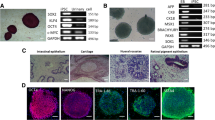Abstract
The adult mammalian auditory receptor lacks any ability to repair and/or regenerate after injury. However, the late developing cochlea still contains some stem-cell-like elements that might be used to regenerate damaged neurons and/or cells of the organ of Corti. Before their use in any application, stem cell numbers need to be amplified because they are usually rare in late developing and adult tissues. The numerous re-explant cultures required for the progressive amplification process can result in a spontaneous differentiation process. This aspect has been implicated in the tumorigenicity of stem cells when transplanted into a tissue. The aim of this study has been to determine whether cochlear stem cells can proliferate and differentiate spontaneously in long-term cultures without the addition of any factor that might influence these processes. Cochlear stem cells, which express nestin protein, were cultured in monolayers and fed with DMEM containing 5% FBS. They quickly organized themselves into typical spheres exhibiting a high proliferation rate, self-renewal property, and differentiation ability. Secondary cultures of these stem cell spheres spontaneously differentiated into neuroectodermal-like cells. The expression of nestin, glial-fibrillary-acidic protein, vimentin, and neurofilaments was evaluated to identify early differentiation. Nestin expression appeared in primary and secondary cultures. Other markers were also identified in differentiating cells. Further research might demonstrate the spontaneous differentiation of cochlear stem cells and their teratogenic probability when they are used for transplantation.



Similar content being viewed by others
References
Basura GJ, Eapen R, Buchman CA (2009) Bilateral cochlear implantation: current concepts, indications, and results. Laryngoscope 119:2395–2401
Breuskin I, Bodson M, Thelen N, Thiry M, Nguyen L, Belachew S, Lefebvre PP, Malgrange B (2008) Strategies to regenerate hair cells: identification of progenitors and critical genes. Hear Res 236:1–10
Hu Z, Ulfendahl M (2006) Cell replacement therapy in the inner ear. Stem Cells Dev 15:449–459
Knoepfler PS (2009) Deconstructing stem cell tumorigenicity: a roadmap to safe regenerative medicine. Stem Cells 27:1050–1056
Kojima K, Tamura S, Nishida AT, Ito J (2004) Generation of inner ear hair cell immunophenotypes from neurospheres obtained from fetal rat central nervous system in vitro. Acta Otolaryngol Suppl 551:26–30
Lendahl U, Zimmerman LB, McKay RD (1990) CNS stem cells express a new class of intermediate filament protein. Cell 60:585–595
Li H, Roblin G, Liu H, Heller S (2003) Generation of hair cells by stepwise differentiation of embryonic stem cells. Proc Natl Acad Sci USA 100:13495–13500
Limb CJ (2006) Cochlear implant-mediated perception of music. Curr Opin Otolaryngol Head Neck Surg 14:337–340
Lopez IA, Zhao PM, Yamaguchi M, Vellis J de, Espinosa-Jeffrey A (2004) Stem/progenitor cells in the postnatal inner ear of the GFP-nestin transgenic mouse. Int J Dev Neurosci 22:205–213
Lou X, Zhang Y, Yuan C (2007) Multipotent stem cells from the young rat inner ear. Neurosci Lett 416:28–33
Malgrange B, Belachew S, Thiry M, Nguyen L, Rogister B, Alvarez ML, Rigo JM, Van De Water TR, Moonen G, Lefebvre PP (2002) Proliferative generation of mammalian auditory hair cells in culture. Mech Dev 112:79–88
Martinez-Monedero R, Edge AS (2007) Stem cells for the replacement of inner ear neurons and hair cells. Int J Dev Biol 51:655–661
Matsui JI, Parker MA, Ryals BM, Cotanche DA (2005) Regeneration and replacement in the vertebrate inner ear. Drug Discov Today 10:1307–1312
Moyer M, Bullrich F, Sheffield JB (1990) Emergence of flat cells from glia in stationary cultures of embryonic chick neural retina. In Vitro Cell Dev Biol 26:1073–1078
Oshima K, Grimm CM, Corrales CE, Senn P, Martinez Monedero R, Geleoc GS, Edge A, Holt JR, Heller S (2007) Differential distribution of stem cells in the auditory and vestibular organs of the inner ear. J Assoc Res Otolaryngol 8:18–31
Rivolta MN, Li H, Heller S (2006) Generation of inner ear cell types from embryonic stem cells. Methods Mol Biol 330:71–92
Savary E, Hugnot JP, Chassigneux Y, Travo C, Duperray C, Van De Water T, Zine A (2007) Distinct population of hair cell progenitors can be isolated from the postnatal mouse cochlea using side population analysis. Stem Cells 25:332–339
Torres M, Giráldez F (1998) The development of the vertebrate inner ear. Mech Dev 71:5–21
Acknowledgements
The authors are grateful to Dr. Adam J. Donne (Department of Otolaryngology, Alder Hey Children’s NHS Foundation Trust, Liverpool, UK) for his useful scientific comments and the English revision of the present paper and to Dr. Jose M. Ejeda for his valuable technical work with cell cultures and immunocytochemical processing.
Author information
Authors and Affiliations
Corresponding author
Rights and permissions
About this article
Cite this article
Carricondo, F., Iglesias, M.C., Rodríguez, F. et al. In vitro long-term development of cultured inner ear stem cells of newborn rat. Cell Tissue Res 342, 13–19 (2010). https://doi.org/10.1007/s00441-010-1039-8
Received:
Accepted:
Published:
Issue Date:
DOI: https://doi.org/10.1007/s00441-010-1039-8




